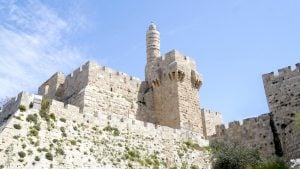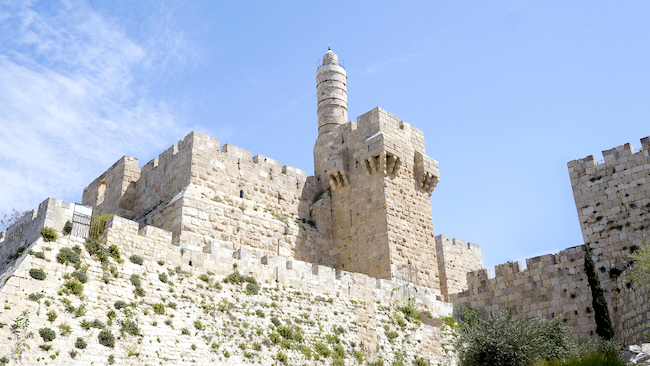
Yechezkel 45:16
This week’s haftorah, read in conjunction with Parshas Hachodesh presents the upcoming month of Nissan in a magnificent light. It begins with an elaborate description of the special order of sacrifices to be brought in the Messianic era. The prophet Yechezkel focuses on the dedication of the third Bais Hamikdash wherein a bullock will be offered to introduce the sacrificial services. He says, “On the first day of the first month (Nissan) take a perfect bullock and purify the Bais Hamikdash.” (45:18) The Radak (ad loc.) explains that the Jewish nation will return to Eretz Yisroel long before the month of Nissan. During those months the bulk of the Bais Hamikdash will be rebuilt leaving only final stages for the month of Nissan. He suggests that the dedication services will actually begin seven days before Nissan and will be completed on Rosh Chodesh. With this he interprets the words of Chazal which state, “In Nissan we were redeemed and in Nissan we are destined to be redeemed” These words, in his opinion, refer to the prediction of our Haftorah wherein we are informed that the actual Bais Hamikdash service will begin in the month of Nissan.
As we follow this pattern closely we discover a striking similarity between the dedication of the Bais Hamikdash and the Mishkan. Historically speaking, each of them revolves around the month of Nissan. In fact they are both completed on the exact same date, Rosh Chodesh Nissan. But this particular date suggests an even more meaningful dimension. The month of Nissan, as we know, has a special connotation to the Jewish people. It was in this month that we were redeemed from Egyptian bondage and, in fact, this redemption process began on the first of Nissan. This can be learned from this week’s Maftir reading which states that it was on Rosh Chodesh Nissan that Hashem informed the Jewish people of their redemption and began preparing them for it. These perfect similarities suggest a direct corollary between the Jewish people’s redemption and the erection of the sanctuary and Bais Hamikdash. Rosh Chodesh Nissan, the day which introduced our redemption, also introduced the service of the Mishkan and will ultimately introduce the service of the final Bais Hamikdash.
In search for an appreciation of this relationship we refer to the Ramban’s classic overview on Sefer Shemos. In essence, Sefer Shemos consists of the Jewish people’s exile and redemption, beginning from the descent of Yaakov and his family to Egypt extending through the Jewish nation’s exodus from Egypt. Yet, nearly half the sefer is devoted to the intricacies of the construction of the Sanctuary, a subject seemingly unrelated to our redemption from Egypt! The Ramban explains that the Jewish people’s exile and redemption extended far beyond the physical dimensions of Egypt and Israel. Prior to their exile, Yaakov and his sons enjoyed a very close relationship with Hashem in the land of Israel. The greatness of the Patriarchs produced such intense levels of sanctity that Hashem’s presence amongst them was virtually a tangible experience. When the family of Yaaakov descended from Eretz Yisroel to Egypt they began forfeiting this experience and, to some degree, became exiled from Hashem. In fact, over hundred of years in Egypt they had severely distanced themselves from Hashem and lost their association with Him. Even after they were liberated from Egyptian bondage scars of exile remained deeply imprinted on them. They began rebuilding their relationship with Hashem and prepared for their long journey homeward. Finally, with the erection of the Sanctuary they reached their ultimate destination and completely united with Hashem. The Sanctuary represented a tangible experience of Hashem’s presence amongst His people, the clearest indication of this reunification with Him. As the Ramban sees it, the Jewish people’s redemption was now complete. They finally returned to their original status, being totally bound up with their Creator. All scars of exile were now healed and they finally returned home to Hashem, enjoying the closest imaginable relationship with their beloved Hashem.
This perspective is best expressed in the words of Chazal in P’sikta Rabsi. Our Chazal inform us there that, in reality, the construction of the Sanctuary was completed in the month of Kislev. However, Hashem waited until Nissan, the month of the Patriarchs, for the erection and dedication of the Mishkan. If we follow the line of reasoning of the Ramban we can truly appreciate the message of this P’sikta. As stated, the erection of the Sanctuary represented the completion of the Jewish redemption, their reunification with Hashem. This unification was so intense that it actually resembled the glorious relationship between Hashem and the Patriarchs. In essence the Jewish status of the time reflected that of the Patriarchs in whose merit this relationship was reinstated. It was therefore only proper to wait until Nissan for the dedication of the Sanctuary. The month of Nissan, the month of the Patriarchs, was therefore chosen for this dedication, the experience which reflected the Jewish people’s return to the status of the Patriarchs.
This sense of redemption will extend itself even into the Messianic era and the final Bais Hamikdash. Our ultimate redemption, as in all previous redemptions, will not be completed until our return to Hashem. Irrespective of our location on earth we will remain exiled from Hashem until we will merit His Divine Presence. Even after our return to Eretz Yisroel, long before Nissan, we will continue to bear the scar tissue of two thousand years of exile. Only with Hashem’s return to His people, resting His presence amongst us, will we be truly redeemed. This magnificent display will, obviously, occur in the month of Nissan. Our final redemption marking Hashem’s return to His people will join the ranks of redemption and will be introduced on that glorious day, Rosh Chodesh Nissan.


